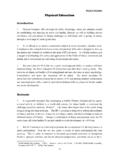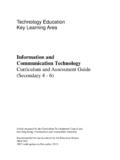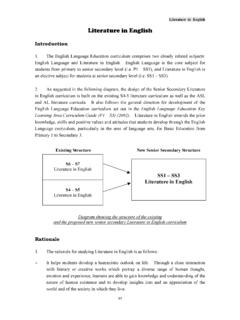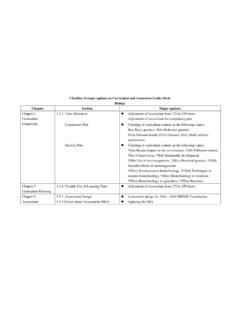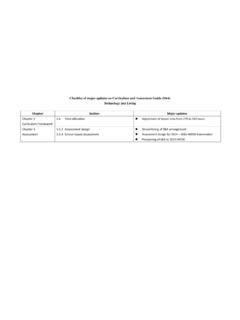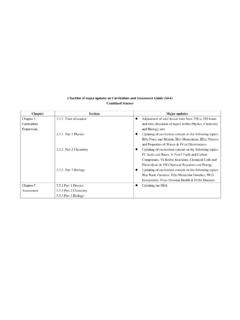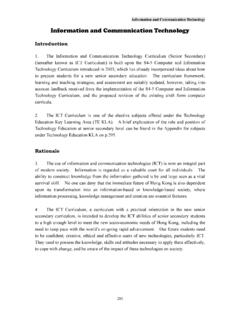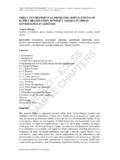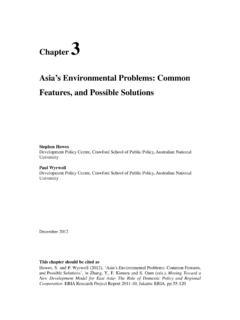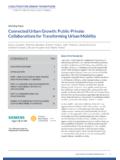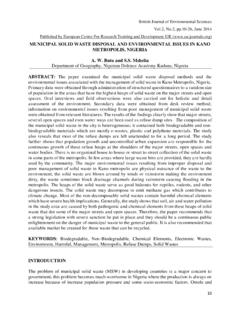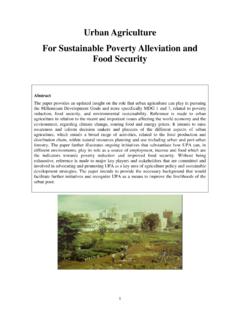Transcription of Geography - hkedcity.net
1 Geography 137 Geography Introduction 1. Geography as a discipline enables us to understand the Earth we are living in from a spatial perspective. It offers a systematic framework for enquiry into questions about the world that surrounds us. Geography provides a bridge between the social sciences and the physical sciences, through the provision of an understanding of the dynamics of cultures, societies and economies on the one hand, and those of physical landscapes and environmental processes on the other. 2. Geography as a secondary school subject enables students to explore and understand the relationship between the Earth and its peoples through the study of space, place and environment. These three elements (or macro-concepts) form the core of Geography in secondary education. In pursuit of such an understanding, the questions What , Where , How , Why and What if are central and are the basic constructs for developing a geographical framework for enquiry.
2 3. The study of Geography at senior secondary level is built on the knowledge and skills students will have acquired in the junior secondary curriculum. These include the concepts and knowledge embedded in the various strands of the PSHE Curriculum, in particular Strand 4 Place and Environment . Students completing the junior secondary Geography curriculum will also have acquired basic enquiry and generic skills, and have had experience of making values judgements through investigating issues from a geographical perspective. Rationale 4. As an elective PSHE subject in the senior secondary curriculum, Geography aims to provide students with an understanding of the Earth and the modern world. Through examining the interrelationship among people, place and environment it helps students to acquire an in-depth understanding of the changing contemporary world in terms of space and environment.
3 5. Hong Kong, as an international metropolitan city, provides a rich context for Geography students to develop a global outlook, an awareness of the influence of globalisation and an appreciation of the importance of international cooperation in tackling global issues. Senior secondary geographical education seeks to use this rich context to enable students to gain a deeper understanding of the changing world, the changing environment and the changing economy. On the other hand, the study of Geography will help students develop a sound knowledge of our nation. It will help students to face Geography 138challenges posed by population explosion, environmental pollution, regional socio-economic inequality, resource depletion, etc., all of which are becoming ever more prominent in China, as well as in the world in general.
4 6. Moreover, the study of Geography also provides opportunities for students to develop their general intellectual capacity for life-long learning, and for generic skills such as critical thinking, communication, information processing, problem solving, decision-making etc. The enquiry approach adopted in Geography enables students to develop the important abilities involved in values clarification and values judgement, which are fundamental to whole-person development. Geographical education provides students with learning experiences which enable them to see the relationships between the individual, society and the environment, and through this to develop skills which can be transferred to other learning and life situations. 7. The study of Geography in senior secondary schools provides students who will study Geography in the universities with a solid conceptual foundation, while for those who will enter university to study other subjects (such as Arts or Social and environmental Sciences), it will have provided exposure to higher order thinking.
5 For all students, it provides a spatial perspective towards socio-economic and environmental issues, a focus on citizenship and on national and global identity, and opportunities for developing generic skills such as the ability to analyse and synthesise, to solve problems, to communicate and to use information technology. The subject also prepares students for a range of career choices in which a global perspective, environmental ethics and awareness, and a sound sense of space and region are specifically needed. More obvious examples of such careers include urban and transport planning, resources and environmental management, tourism and recreation, and at a broader level administration and business. 8. In brief, senior secondary geographical education will equip our students to become geographically informed and inquiring people people who see meaning in the arrangement of things in space; who see relations between people, place and environment; who ask geographical questions and find answers through enquiry; who use geographic knowledge and skills in solving problems; and who apply spatial and ecological perspectives to life situations.
6 Curriculum Aims 9. The aims of the curriculum are to enable students to: (a) understand the Earth they inhabit, and enable them to recognize and interpret, from a spatial perspective, the arrangement of phenomena and features on Earth, the processes at work, the interactions that occur, the changes that result, and the issues Geography 139and management responses that arise; (b) develop the general intellectual capacity and generic skills needed for life-long learning through geographical enquiry, and the ability to apply these in life situations; (c) appreciate the wonder, interdependence and fragility of the local and global environment, and the importance of promoting sustainable development; and (d) develop a sense of citizenship and a global outlook, and readiness to take action for the betterment of society, the nation and the world.
7 Curriculum Objectives 10. Students are expected to develop knowledge and understanding about: (a) how natural environments influence human activities, and how human activities alter natural environments; (b) the changing development of geographical phenomena and issues in terms of space and time; (c) the characteristics and functioning of major natural environments, through analysing the processes and interactions within and between; (d) the characteristics and development of major human activities in order to achieve a sense of region; (e) the issues arising from people-environment interactions and the human responses to such issues, as well as the implications of these human responses for resource management; 11. Students are expected to develop (a) geographical inquiry skills, including the ability to: (i) identify and ask questions from a geographical perspective; (ii) locate, select and extract appropriate information and data from primary and secondary sources ( the field, surveys, documents, maps, charts, ground and aerial photos, Geographic Information System [GIS] data), which require the ability to observe and record data systematically and accurately; (iii) present and organise information and data.
8 This comprises the ability to: use appropriate techniques for summarising ( descriptive statistics such as measures of central tendency and variability); use appropriate formats, such as texts ( reports, tables, summaries, etc.) and illustrations (such as maps, diagrams, models, sketches, graphs, etc.); Geography 140(iv) compare, analyse, synthesise and evaluate, in order to interpret information and data for making inferences and drawing conclusions. This comprises the ability to: use appropriate statistical techniques ( correlation) analyse spatial patterns using GIS (v) To evaluate the findings, solutions or conclusions drawn from the inquiry. (b) generic skills of communication, critical thinking, problem-solving skills and creativity through geographical inquiry, in particular the ability to: (i) select appropriate means of effective communication; (ii) draw out meaning from information, and determine what to believe and what not to believe; (iii) analyse problems through logical reasoning, and determine the optimal course of action from a number of alternatives; (iv) view situations from different perspectives and adopt appropriate approaches to analyse problems.
9 12. Students are expected to develop values and attitudes so that they may: (a) develop a sense of wonder, enjoyment and curiosity about peoples, places and environments; (b) show respect for all peoples, their cultures, values and ways of life; (c) recognize environmental problems and take appropriate action to promote sustainable development; (d) cultivate a sense of belonging to society and nation and to become active and responsible citizens; (e) be aware of the increasing global interdependence of peoples and nations, and to appreciate the importance of international solidarity and cooperation. Curriculum Framework (This part should be read in conjunction with the section Curriculum Framework of the Main Document. It should be noted that the curriculum framework suggested below is for initial consultation only. Feedback from the public will be taken into account and further details will be provided in the next stage of consultation.)
10 13. The new senior secondary Geography curriculum is developed on the basis of the newly revised S4-S5 Geography Curriculum (2003). The existing content of 6 themes and 6 issues are retained as far as possible, with an appropriate updating of knowledge and information, a broadening of coverage and an increase in depth. Geography 14114. The proposed curriculum comprises a compulsory part and an elective part. The compulsory part accounts for 80% of the total curriculum time. The compulsory part aims to assist students to acquire fundamental geographical concepts and knowledge and to develop a framework of thinking and enquiry essential for further study, career development and lifelong learning. The elective part, taking up the remaining 20% of lesson time, comprises a number of elective modules to cater for the varied aptitudes, interests and needs of students.
